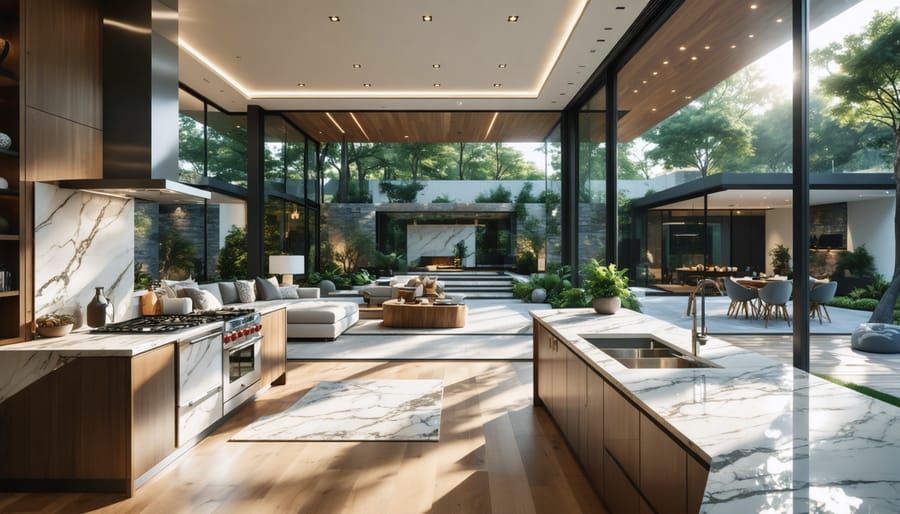Begin by identifying your most repetitive daily tasks and consider automating them with smart devices to save time and effort. Choose versatile devices like smart plugs and bulbs that integrate easily with existing systems, offering flexibility for beginners. Focus on connectivity by setting up a reliable home network to ensure your devices communicate efficiently. Explore the magic of smart home systems to transform your living space with seamless technology integration. Start small by installing a basic voice assistant like Alexa or Google Home to control your setup hands-free. Prioritize security by incorporating smart locks and cameras, enhancing safety and peace of mind. Keep expanding your smart home ecosystem gradually, learning through experience while refining solutions to meet your lifestyle needs. Use these steps as a foundation for creating a smarter, more efficient home environment.
Why Consider Home Automation?

Enhanced Convenience
Imagine waking up to the smell of freshly brewed coffee and the gentle rise of blinds to greet the morning sun. Home automation makes this dream a reality by seamlessly integrating technology into everyday routines, tailored just for you. With smart devices, you can program your thermostat to adjust to your ideal temperature as you arrive home or schedule lights to turn on just as you walk through the door. It’s like having a personal assistant at your fingertips, simplifying everything from adjusting lighting for movie nights to ensuring your home is secure. This newfound convenience allows more time for what truly matters—memorable moments with loved ones.
Improved Home Security
Home automation offers remarkable security enhancements, turning your living space into a fortress of peace and safety. Imagine receiving instant alerts on your smartphone whenever the doorbell rings or a window is opened unexpectedly. Smart cameras and door locks provide real-time monitoring and control, allowing you to check in on your home from anywhere. These devices not only deter potential intruders but also offer peace of mind with features like motion detection and two-way audio. For a seamless DIY experience, start by integrating a smart doorbell or a couple of smart cameras; they’re easy to set up and provide robust protection right out of the box.
Energy Management
Home automation is not just about convenience; it’s a smart way to boost energy efficiency and save money. With automated systems, you can program your thermostat to adjust temperatures when you’re not home, ensuring you aren’t wasting energy. Smart lights can be scheduled to turn off when you leave a room or dimmed in accordance with natural sunlight, reducing electricity usage. Even small steps, like using smart plugs, allow appliances to power down completely when not in use. By taking these actions, DIY enthusiasts and homeowners can enjoy a greener, more cost-effective home, making every watt count without hefty utility bills.
Getting Started: Essential Components
Smart Hubs and Controllers
Smart hubs play a crucial role in a home automation setup by acting as the central command center that connects and controls all your smart devices. Imagine having various smart lights, thermostats, and security cameras all working seamlessly together; a smart hub makes this possible. By integrating different devices into one system, you can create automated routines, like dimming the lights and locking the doors when you say “goodnight.” For beginners, starting with a hub simplifies managing multiple devices, reducing the need for numerous apps on your phone. It’s your gateway to a more efficient, convenient, and smarter home environment.

Smart Lighting
Discovering the world of smart lighting solutions can illuminate more than just your living spaces—it transforms your entire home ambiance and boosts energy efficiency. Imagine adjusting the brightness to set the perfect mood, or even changing colors with a tap, adding personality and warmth to any room. Many systems also allow for scheduling, meaning lights are only on when needed, helping to cut down your energy bills. With user-friendly apps and easy installation, smart lighting offers both comfort and functionality, providing an inspiring first step into the realm of home automation.

Smart Thermostats
Smart thermostats are a fantastic first step into home automation, offering convenience and energy savings. These devices allow you to control your home’s temperature remotely using your smartphone, which is particularly useful for maintaining comfort while maximizing efficiency. They learn your preferences over time, adjusting automatically to suit your schedule, and often provide valuable insights into your energy usage. By installing a smart thermostat, you’ll not only enjoy a more comfortable living space but also contribute to reducing energy bills. It’s the perfect addition to consider alongside the best smart home security systems to enhance your home’s automation journey. Get started with easy-to-follow DIY setup guides, and watch as your home becomes more intelligent and efficient.
Voice Assistants
Voice assistants like Amazon Alexa, Google Assistant, and Apple’s Siri make home automation a breeze for beginners. Simply speak your commands, and they’ll turn on lights, adjust thermostats, or play music. These smart helpers seamlessly integrate with many devices, offering a hands-free, convenient way to start automating your home.
Step-by-Step DIY Home Automation Setup
Embarking on your DIY home automation journey can be both exciting and rewarding. Here’s a warm, step-by-step guide to get you started, even if you’re new to the concept. First, begin by identifying the areas where you want automation. Common choices are smart lighting, thermostats, and security systems. These changes can enhance both convenience and efficiency in your home.
1. **Choose Your Platform**: Decide on a central hub or platform, like Google Home, Amazon Alexa, or Apple HomeKit, that will allow different smart devices to communicate. This simplifies the process and offers you control through a single application.
2. **Start Simple**: Kick things off with smart light bulbs. They’re easy to install—simply replace your existing bulbs and connect them to your platform’s app. This small change can dramatically alter the ambiance and energy efficiency of your spaces.
3. **Upgrade Temperature Control**: Installing a smart thermostat is another manageable task suitable for beginners. It involves a bit of wiring but comes with instructions and can lead to significant savings on your energy bill by adjusting temperatures based on your schedule.
4. **Add Security Features**: Consider smart security cameras or doorbells. These are usually battery-powered or can be plugged into existing wiring and connect directly to Wi-Fi, providing peace of mind with real-time alerts and remote monitoring.
5. **Learn and Expand**: Once comfortable, explore further options like smart locks, automated blinds, or connected appliances. Always prioritize compatibility with your chosen platform for seamless integration.
While tackling home automation might seem daunting at first, taking it one step at a time and focusing on key areas can ultimately transform your living space into a smart home oasis. Enjoy the process and the newfound convenience that comes with it.
Expert Tips for Maximizing Your Home Automation Experience
Begin by identifying your needs—assess which automation elements will enhance your daily routine. Next, prioritize smart devices that seamlessly integrate. Think about starting small with a smart speaker or lighting system. To maximize efficiency, establish routines or scenes that trigger multiple actions with a single command. For instance, a “Good Night” scene could lock doors and turn off lights. Use insights from your device’s app to track usage patterns and optimize settings based on your lifestyle. Maintain a secure network by regularly updating your devices and using strong passwords. If you’re confident with tools, consider DIY installation projects to add a personal touch and save costs. Don’t hesitate to experiment with device placement for optimal performance; sometimes, a small shift can boost connectivity. Finally, explore community forums or groups for creative ideas and solutions to common challenges, ensuring you’re always learning and enhancing your setup.
Common Challenges and Solutions
Starting with home automation can sometimes feel like diving into a vast ocean of possibilities, but don’t worry—you’re not alone in facing a few common hurdles. One frequent challenge is compatibility between devices. Imagine investing in smart gadgets only to find they don’t communicate well with each other. The solution? Focus on picking products that operate on the same platform or utilize a central smart hub compatible with various brands.
Another typical issue is the confusing initial setup. The jargon and tech-lingo can seem overwhelming at first. Here’s a pro tip: follow step-by-step online resources or watch tutorial videos that break down the process into simple actions. Don’t hesitate to join online communities or forums where many enthusiasts share advice based on their experiences.
Network connectivity is another bump in the road many encounter. Home automation relies heavily on Wi-Fi, so consider upgrading your router if signal strength or range is lacking. A mesh Wi-Fi system can ensure consistent signals throughout your home, allowing all devices to operate smoothly.
Finally, maintaining security is crucial. Begin with basic tips like setting strong passwords and ensuring all software and firmware are regularly updated. By tackling these common challenges with the right approach, you’ll lay a strong foundation for a smart home that truly enhances your lifestyle.
Conclusion
Embracing home automation can transform your living space into a more efficient, enjoyable environment. By integrating devices like smart thermostats, lights, and security systems, you can tailor your home to respond to your lifestyle with just a few taps or voice commands. Whether you’re a homeowner eager to upgrade your house or a renter looking to incorporate smart solutions, starting your home automation journey can be as simple as choosing devices that align with your needs and budget. With the expert tips and DIY guides shared throughout this article, you’re equipped with the knowledge to make informed decisions and tackle potential challenges with confidence. Remember, the goal is to create a more comfortable and convenient home, reflecting your personality and improving your quality of life. So, take the first step today towards a smarter home—it’s a rewarding process that’s sure to pay off in comfort and savings.





